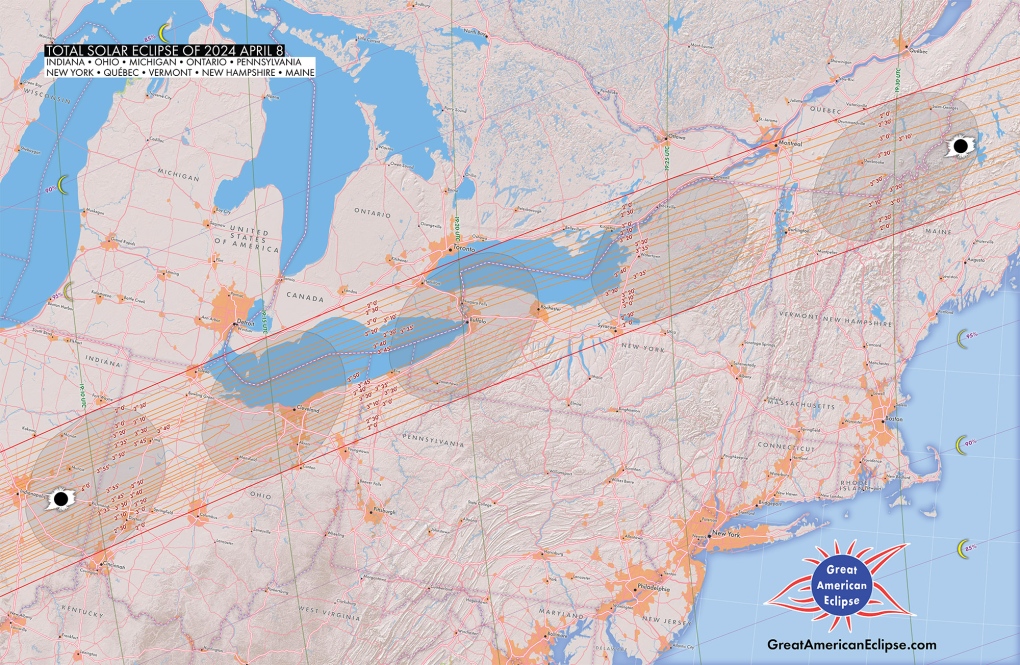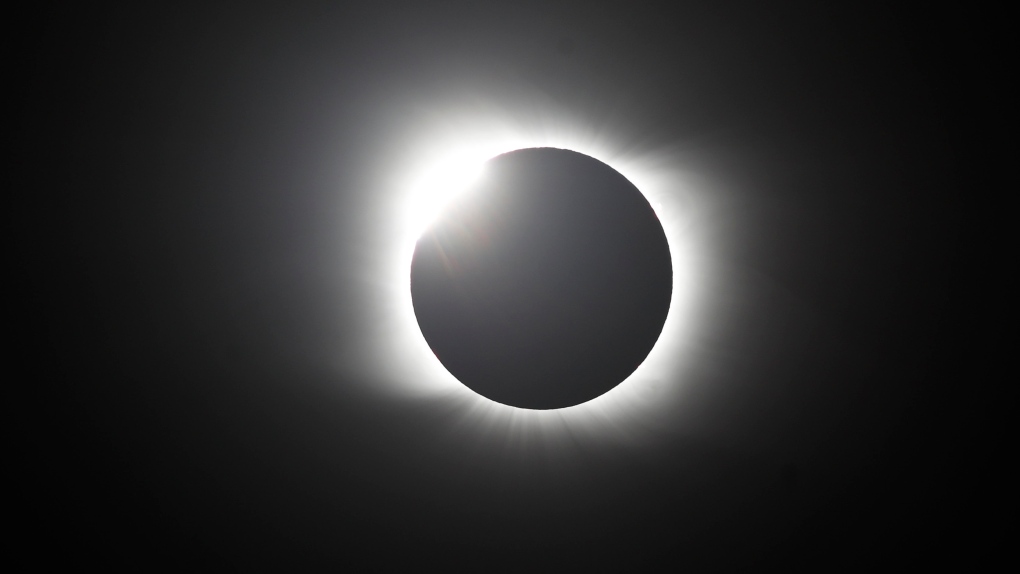All of the provinces in eastern Canada will experience a total solar eclipse on April 8, 2024.
If skies are clear, Canadians from Point Pelee in southwestern Ontario to Gander in northeastern Newfoundland will be able to witness the celestial spectacle that Monday afternoon.
“This is an extremely rare astronomical event,” York University astronomer and professor Elaina Hyde told CTVNews.ca via email. “Only a small area of the Earth is going to be able to see the full solar eclipse (what we call totality) and many people go their whole lives without ever viewing one.”
A total solar eclipse occurs when the moon passes directly between the earth and sun, completely blocking the sun’s face and leaving a fiery ring. While total solar eclipses occur about once every 18 months, you need to be directly along the eclipse’s specific path to see the full effect. Most Canadians haven’t had the chance since 1979.
“The skies will go dark, stars will appear (if it is clear weather) and an area around the sun called the corona (normally washed out by the rest of the suns light) becomes visible,” Hyde, who is also the director of the Allan I Carswell Observatory in Toronto, explained. “It is a striking sight and I’m certainly hoping to travel and see it.”
This map shows the path of totality of the April 8, 2024 solar eclipse. (Michael Zeiler/GreatAmericanEclipse.com)This map shows the path of totality for the April 8, 2024 solar eclipse. (Michael Zeiler/GreatAmericanEclipse.com)
About 100 km wide, the April eclipse’s path of totality will stretch northeast across the continent from Mazatlan on Mexico’s Pacific coast and then through U.S. cities such as Dallas, Little Rock, Indianapolis, Cleveland and Buffalo.
According to NASA’s calculations, the total eclipse will begin to peak in Canada in the minutes before 3:15 pm local time for communities near the north shore of Lake Erie in southwestern Ontario. Minutes later, it will be visible near Lake Ontario – but not in Toronto – and then southern Quebec. After 4:30 pm Atlantic daylight time, central New Brunswick and then western P.E.I. will see the full display before it appears over Newfoundland after 5:10 local time.
 This map shows where and when a total solar eclipse will be visible over Canada on April 8, 2024. (Michael Zeiler/GreatAmericanEclipse.com)This map shows where and when to catch the total solar eclipse in Ontario and Quebec on April 8, 2024. (Michael Zeiler/GreatAmericanEclipse.com)
This map shows where and when a total solar eclipse will be visible over Canada on April 8, 2024. (Michael Zeiler/GreatAmericanEclipse.com)This map shows where and when to catch the total solar eclipse in Ontario and Quebec on April 8, 2024. (Michael Zeiler/GreatAmericanEclipse.com)
Canadian towns and cities with clear views include Port Dover, Niagara Falls, Hamilton, Belleville, Kingston, Cornwall, Sherbrooke, Saint-Georges, Fredericton and Miramichi. Parts of southern Montreal will be able to glimpse the phenomena, but likely not the northern part of the island. In Nova Scotia, just the northernmost tip of Cape Breton Island will quickly see the total eclipse around 4:40 pm local time, according to the website eclipse2024.org.
Depending on your location in Canada, the total eclipse will be visible for anywhere from just a few seconds to approximately three-and-a-half minutes near the centre of the path of totality. Those in cities just outside its path like London, Toronto, Ottawa, Laval, Quebec, Moncton, Charlottetown and St. John’s still have reason to look up.
“If you are just outside the main area of the eclipse you will get a partial eclipse, which requires you to keep on solar-safe glasses and will not have the dramatic sky darkening or visible corona,” Hyde said.
 This map shows where and when a total solar eclipse will be visible over Canada on April 8, 2024. (Michael Zeiler/GreatAmericanEclipse.com)This map shows where and when to catch the total solar eclipse in Quebec, New Brunswick, P.E.I., Nova Scotia and Newfoundland on April 8, 2024. (Michael Zeiler/GreatAmericanEclipse.com)
This map shows where and when a total solar eclipse will be visible over Canada on April 8, 2024. (Michael Zeiler/GreatAmericanEclipse.com)This map shows where and when to catch the total solar eclipse in Quebec, New Brunswick, P.E.I., Nova Scotia and Newfoundland on April 8, 2024. (Michael Zeiler/GreatAmericanEclipse.com)
HOW TO PREPARE FOR THE 2024 ECLIPSE
Be sure to watch for about an hour before and after totality see the moon fully transit in front of the sun. It is only safe to remove eye protection in the brief period the sun is blocked. Looking at the sun without protection can cause retinal burns and vision loss. With eye protection, partial eclipses will be visible across most of Canada on April 8, with the exception of parts of Yukon.
To avoid damaging your eyes, proper gear is essential. Glasses with special dark lenses certified for solar viewing with an ISO 12312-2 international standard are the simplest option and relatively inexpensive online, including from the Royal Astronomical Society of Canada. NASA and the American Astronomical Society also offer recommendations. Similar filters are also available for cameras and smartphones.
If you can’t get glasses, the Canadian Space Agency provides instructions for making a DIY solar eclipse projector with little more than a cardboard box, paper, scissors, aluminum foil, a pin and tape. These act like pinhole cameras and will show you a small projection of the eclipse inside the box. Welding helmets with shade 12 or higher are also safe, according to NASA. No matter how dark, sunglasses just won’t cut it.
Bill Archer, a mission specialist with the Canadian Space Agency, says there’s also good reason to look down during a solar eclipse to watch shadows transform like thousands of pinhole cameras.
“All those little beads of light that go through the trees, they are little images of the sun, and that’s not a thing we think about because they’re just little dots,” Archer told CTVNews.ca in a telephone interview. “But as the eclipse occurs, the shadows will turn into thousands and thousands of little crescents as the sun gets blocked out by the moon.”
The most recent total solar eclipse in Canada occurred in Aug. 2008, but was only visible in the country’s far north. Before that, Canadians were last treated to a total solar eclipse in Feb. 1979, with Manitoba getting the most spectacular view. After this April, the next Canadian total solar eclipse will occur in Aug. 2044 over parts of Alberta, B.C. and the territories. Atlantic Canada will have its next chance in May 2079.
An annular solar eclipse occurs when the moon is further away from earth and blocks less of the sun, leaving a larger fiery ring. A May 1994 annular solar eclipse was visible in Ontario and Nova Scotia. The next annular solar eclipse will occur over Canada in June 2048.
Archer and Hyde are hoping for clear skies on April 8 so they can both catch their first total solar eclipse.
“Personally I am going to make every effort to get into a location in Canada that will be able to view it,” Hyde said. “If there is bad weather it will be a sad day for astronomers and viewers alike.”




